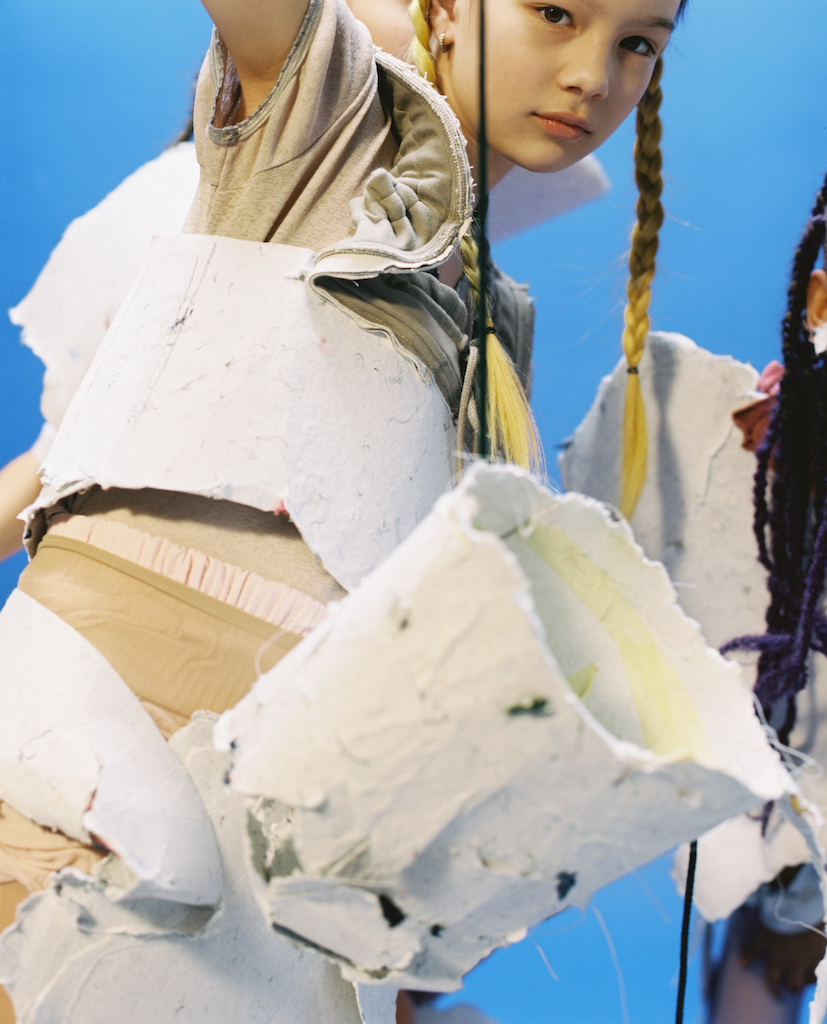“A dictionary begins
when it no longer gives the meaning of words, but their tasks. Thus, formless
is not only an adjective having a given meaning, but a term that serves to
bring things down in the world, generally requiring that each thing have its
form. What it designates has no rights in any sense and gets itself squashed
everywhere, like a spider or an earthworm. In fact, for academic men to be
happy, the universe would have to take shape. All of philosophy has no other
goal: it is a matter of giving a frock coat to what is, a mathematical frock
coat. On the other hand, affirming that the universe resembles nothing and is
only formless amounts to saying that the universe is something like a spider or
spit.”
“Formless” by Georges Bataille, Documents
1, Paris, 1929, p. 382 (translated by Allan Stoekl with Carl R. Lovitt and Donald M.
Leslie Jr., Georges Bataille. Vision of Excess. Selected Writings, 1927-1939,
Minneapolis: University of Minnesota Press “Formless”, p. 31)
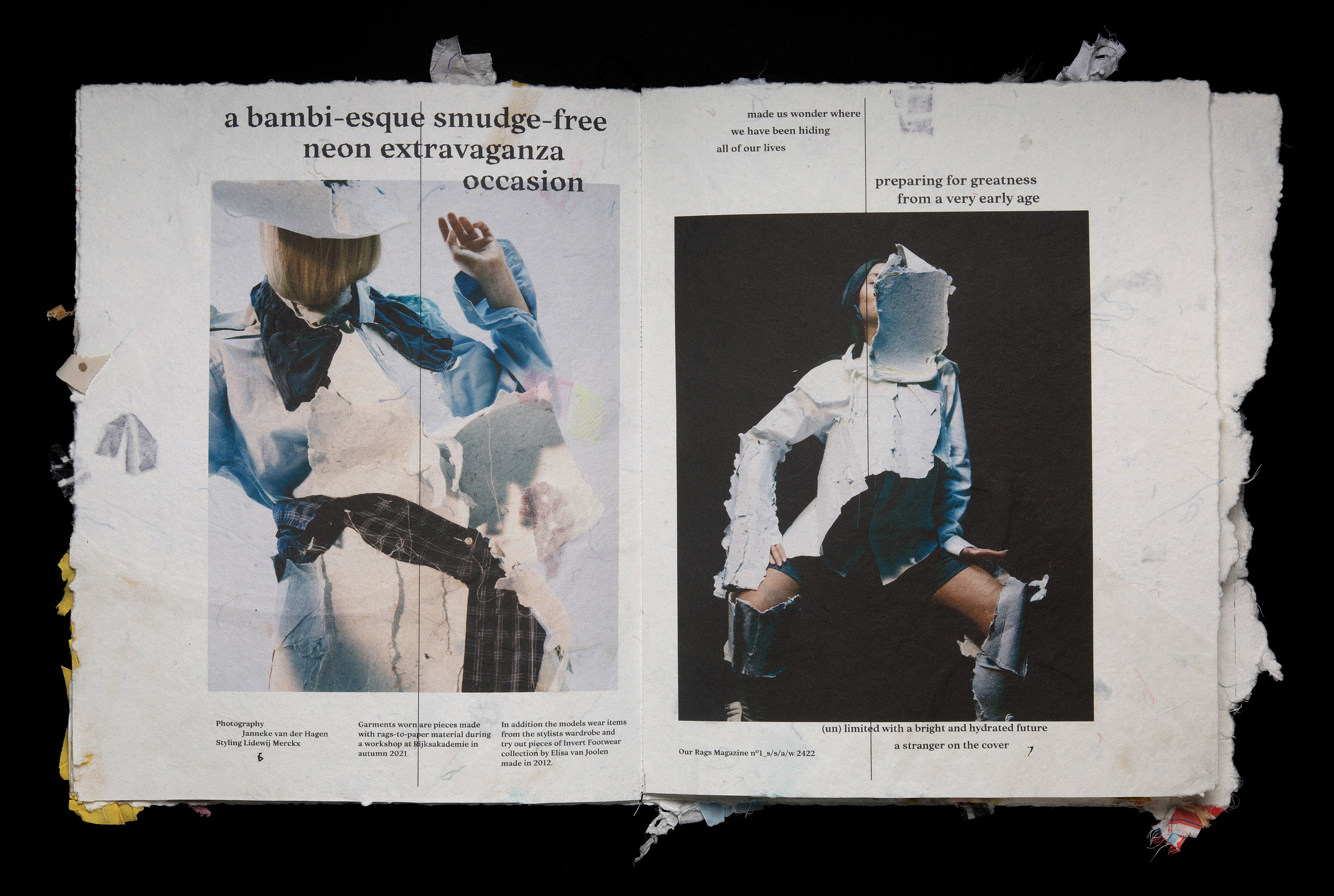
It begins with the planting, growth and
extraction of raw materials that are then processed so thoroughly that nothing
remains of their original form. All that’s left is a macerated pulp, a
formless, fibrous mass, brimming with potential. This mass is then suspended in
water, pulled, drained, couched, and turned into a smooth sheet of non-woven
fibers—a sheet of paper. As a sheet of paper then turns into a page
by being implemented for a specific use, the leaves, soil, rain, wood chips,
bark, all become invisible. Paper emerges from the pulp as temporary,
intermediary—even disposable. It’s luxurious or cheap, durable or frail. It is
used for wrapping, writing, drawing, wiping, and as distance grows from the
sites of production, its formless origins, a sheet of paper is more often the gentle
carrier, in service to an idea, rather than the message itself.
On the glossy pages of a fashion
magazine this transformation is complete. Vogue is printed using M-real's Galerie Fine Gloss
80gsm. These pages are designed, not grown; they echo the
images, the quality desired by the overall editorial scope of the
magazine as they are produced to carry Vogue’s message about fashion, and to be
fashionable themselves. Perhaps Vogue Magazine uses 80gsm coated pulp paper not
only for its brightness and its ability to carry radiant colour well, but also
for its luxurious tactility and the crisp, characteristic sound it makes when
you turn a page—it’s a subtle intermediary for the world Vogue wants to bring
into being. The role it performs is “subliminal” but hidden deeper are the raw
materials, transformed and providing the reader with no idea of the sites and
conditions from which the pages emerged.
In fact, most consumer products
obfuscate the raw materials, sites of extraction, and labour in favour of the designed outcome; origins are
erased by processing and displaced by aesthetic or functional intentions. In
the 1973 ecological dystopian film Soylent Green, Charlton Heston’s
character famously uncovers that the food product served to the downtrodden
residents of New York City in 2022 is made of human remains. This film presents
a resource-strapped deeply environmentally damaged vision of the future and
takes aim at a rapidly globalizing world that had begun to manufacture
petrochemical plastics in staggering volumes, and to shift production offshore,
to blackbox the production of everyday things. It
isn’t a story about cannibalism. Heston’s character is reduced to a desperate,
wounded state, screaming about the suspicious transformation from pulp to
product, happening hidden from view. In the fast fashion and textiles
industries, this market tendency is at an extreme.
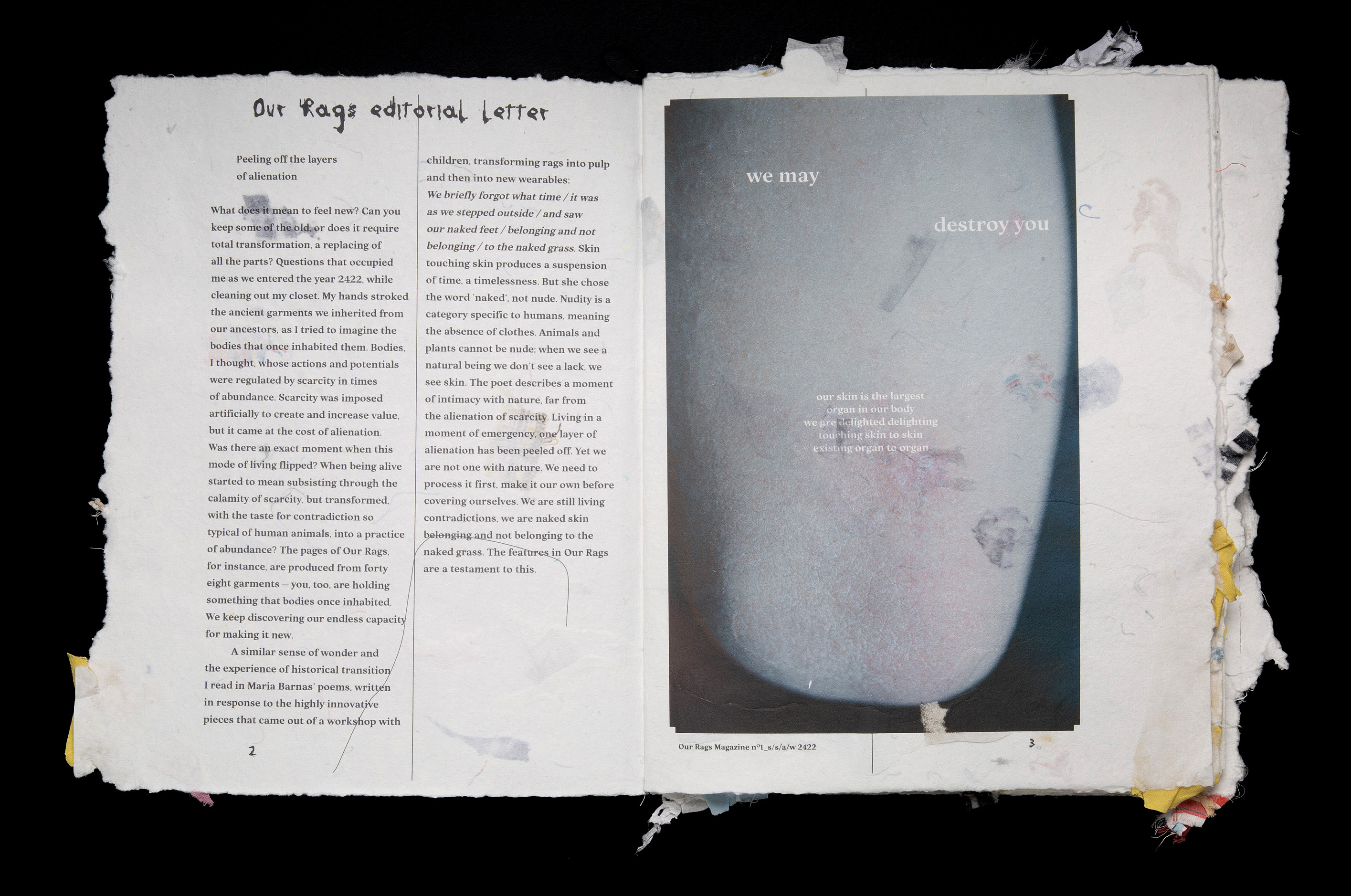
The
origins of raw materials disappear in the transformation from fiber to textile,
and as our interaction with the world becomes increasingly dependent on
screens, the design decisions of fashion products tend to be image-driven or
otherwise immaterial. In other words, the desired outcome—for example, a
white T-shirt—dictates the design decisions rather than experimental or
material-led processes that produce a design. In the hyper-speed fast fashion
industries, materials are often incidental and in service to the desired
outcome: a white T-shirt. They carry a design much in the same way a sheet of
paper carries content as a tool in service to an intention; the materials that
animate the design, like the sheet of paper, are often secondary, attendant to
and in service of a larger aim.
The
effect of this distancing from material and social relations can be felt at
both ends of a garment’s life, from its conception as a design object to its
ultimate disposal by the consumer. This action of disposal is a staggering
convenience, with violent ecological and social effects. This gap, or chasm, really, is a
problem. We need critical perspectives on materiality that, with Annmarie Mol,
stubbornly notice the problems and the potential for radical possibilities in the
figuring of pulp. What is radical here is not the possibilities for content to
be carried on a page, which has—for too long—been reified (or burdened) as
merely the carrier of fashion imagery (and knowledge). The page binds content
and knowledge into a specific form: flat, A4, glossy, brightness .75, caliper
width 0.0025, etc. The alternative is the mass of pulp: Bataille’s notion of l’informe, proposed the infinity of its
formlessness and potential, debased and purely material. This allows us to
imagine loops of meaning, as knowledge and matter spiral in and out of the
pulp. Design from pulp can be circular not only in a material sense, but
epistemologically as well: knowledge circulates and emerges differently as
garments and magazines become carriers of possibility.
This dynamic is expressed and critiqued
in Our Rags Magazine, a collectively designed
speculative fashion magazine created by visual artist Aimée Zito Lema and
designer Elisa van Joolen. The starting point for this collaborative project is
a projection about the future of fashion magazines, in 400 years when we may
not have the luxury of using new resources to produce Fine Gloss 80gsm coated
pulp paper. Desire always endures, but so do materials. Can we imagine a future
world in which new materials cannot be used for fashion? This speculative
fashion magazine is made of the actual garments presented on its large-format
pages, fragments of which are visibly embedded in or dangling from each page.
Following Donna Haraway’s invitation to consider how knowledge can be situated
within the cultural, historical, and political contexts of the knower, this
project invites the additional question: what could a situated material
practice be? The rough texture of these pages is defined by threads, fibers,
shreds, and stitches—this is about representation and knowledge; the paper
is the content and the medium. Our Rags Magazine manifests a critique of the
obfuscation so common in the fashion industry by offering a
radical inversion of Vogue's 80gsm. In other words, by turning clothes
into paper, it overtly leaves material traces of its production and refuses the
smooth separation between medium and content. Where the flat, white, glossy
80gsm paper disconnects us from the web of relations, these pages invite us to
consider the macerated pulp, the formless fibrous mass, and the conditions of
production—and that things can run out.
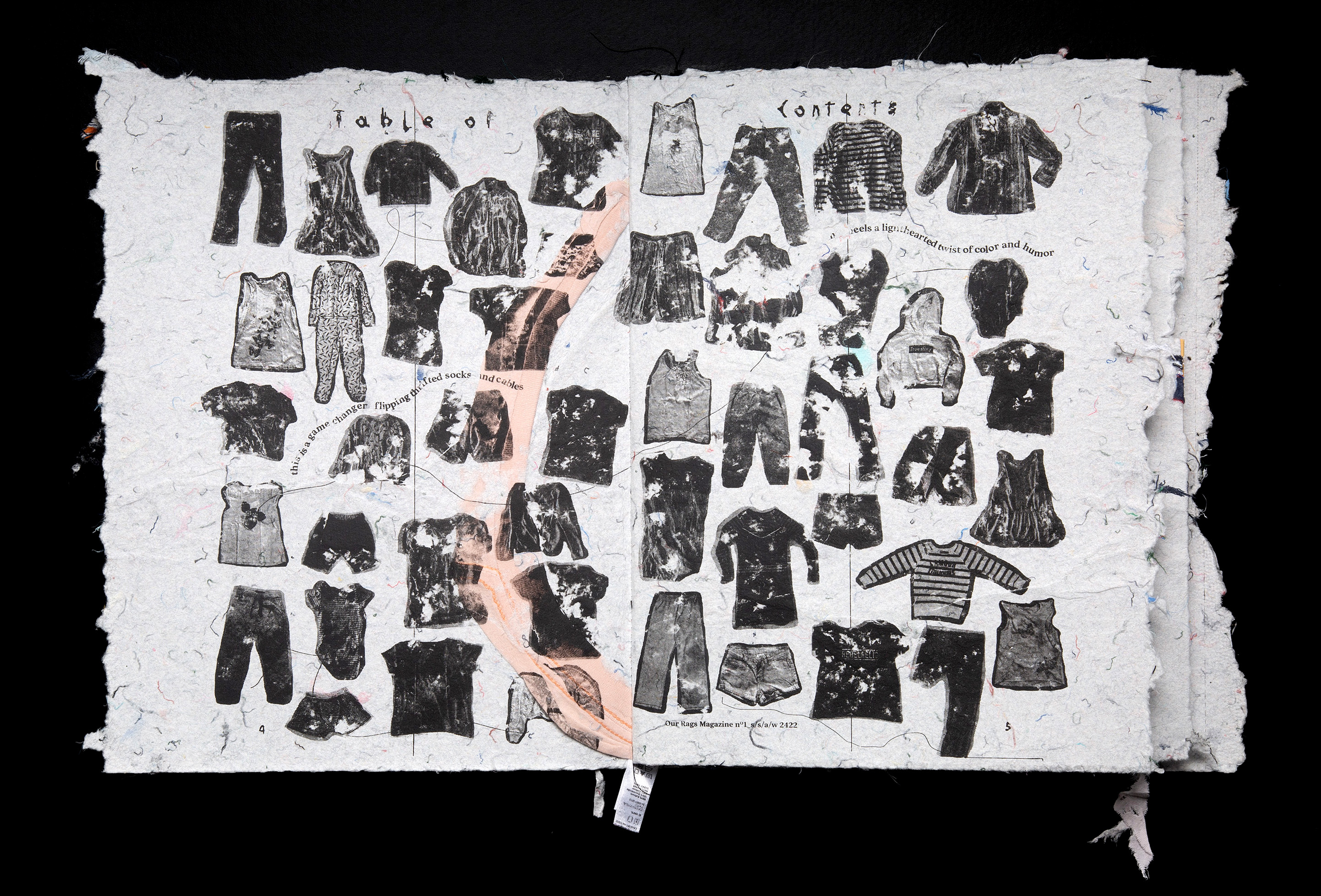
Dystopian or utopian, paper clothing can
represent a vision of a future for manufacturing and fashion. In 1966, to sell
more disposable paper products, American firm Scott Paper ran a campaign in
which they offered two disposable paper dresses, printed to match the
napkins and place settings, any customer who sent in a redeemable coupon and
one dollar. This ignited a two-year fad in North America and Western Europe
that represented an optimistic vision of the future—one in which we humans can
have whatever we want at a very low price, and simply throw it away once it has
exhausted its physical or social potential. Despite this relatively recent
Space-Age innovation, paper was not originally designed to be disposable, and
its earliest forms are durable, circular, and regenerative.
In this project, Zito Lema and van Joolen are drawing
from a long history of early forms of paper that were emerging in Western
Europe in the 11th century—paper made from hemp, linen, cotton and
flax rags. The origins of papermaking can be traced to the Chinese court in 105
CE and was made of plant fibers and silk and cotton rags. The
fundamental steps to produce a sheet of paper haven’t changed much since its
inception in China, from fiber to formless fibrous slurry, to sheet via a
screen of some kind. As the skills made their way along the silk road to
Western Europe, adaptations were made. Plant pulp was not the most common
material for papermaking in Europe until the 19th Century. Until
then, the papermaking industry was reliant on repurposing used clothing and
other textile material, often collected or scavenged by a
“rag-and-bone-man", sorted, detangled, unpicked, unadorned, sliced,
macerated, and turned into a pulp for the papermaker. Since the raw materials
were often scavenged or free in the form of discarded bedlinens, fishing nets,
or clothing, rag paper was cheap and readily available. In fact, recycling was
at the core of the papermaking industries in Europe until German engineering
invited pulp paper production to take hold in the early 19th
century. Holland would eventually become one of the leaders in rag paper
making, providing an example of a “circular economy” before the need to label
it as such emerged. Continuing this history, Zito Lema and van Joolen engaged
the help of the volunteers who run the steam-powered paper mill in Loenen (NL),
where cotton rag paper has been produced for over 400 years.
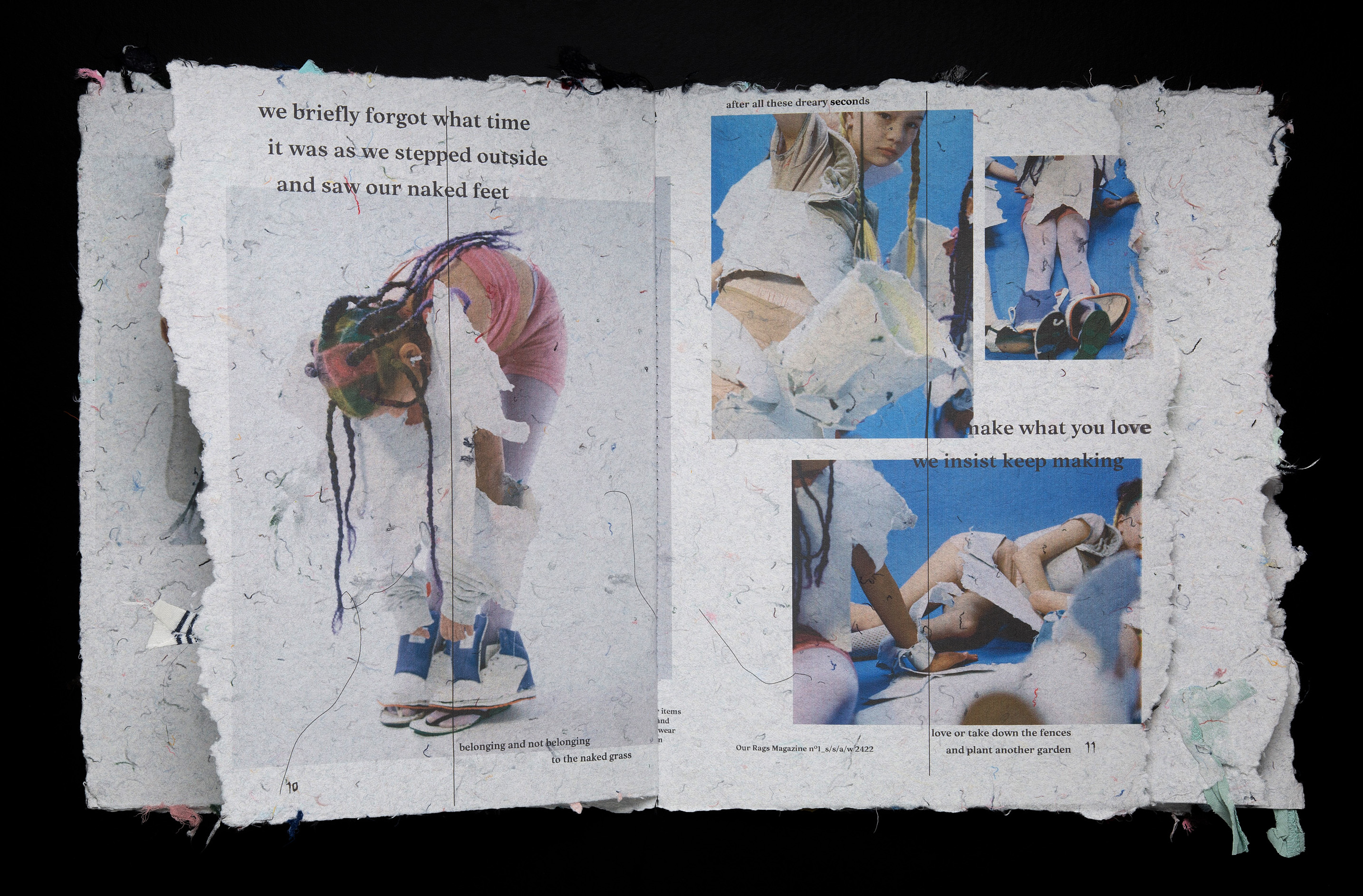
Our Rags Magazine is part of Pulp, an ongoing
project by Zito Lema and van Joolen, where the pair explore the possibilities
for recycling garments into paper via the use of traditional and
nonconventional methods. Our Rags Magazine is at its core a community
practice and was shaped collaboratively via public workshops with children, who
were encouraged to consider how they use and value clothing, and to imagine
radically different ways of dressing and creating garments. Workshop
participants contributed their own garments to be shredded and transformed into
sheets of paper at the Dutch windmill in Leonen. These would later become the
pages of the magazine, and then garments once again; once the pages of the
magazine had been assembled, the participants were given sewing machines,
Velcro, tape, scissors, and pins, and invited to turn the rag paper sheets made
of their garments into new garments.
The traditional European rags-to-paper
is taken another step further as the rags transform to paper and then back to
garments again. This is how a garment in a magazine, is a magazine. A garment
is shredded and transformed into a sheet, becomes a page carrying images of
itself, and is then worn again as a garment. A fundamentally different
relationship between fashion garments and editorial content appears here. In Our
Rags, each swap places after passing through a state of formlessness. From
garment to paper, then to page, to garment again, the cycle suggests an endless
recursive loop of form and content. This was a chance for the young
participants to experience circularity first-hand, a term which has now become
commonplace in our vernacular, but often understood as the domain of companies,
who recycle plastic in enormous, often unseen facilities in Asia.
The editorial fashion
content in Our Rags Magazine embodies this approach to tactile
circularity. Text, image, and paper stock, like any conventional magazine, are
the three ingredients of this publication, but here the editorial aspects (text
and image) of the magazine were created in response to the material parts (paper).
As vehicles themselves, the handmade paper pages carry text and photographs in
various mediums, printed using innovative techniques, as conventional printers
could not handle the material. The magazine is designed by Elisabeth Klement
and includes contributions by photographer Janneke van der Hagen and writers
Maria Barnas and Persis Bekkering. This project emerges from the conditions of
practice—messy and collective—and doesn’t endeavor to hide them. This is not
just about garments, but the knowledge, the editorial content, also surfaced as
the matter of fashion. This
magazine is not just about fashion, it is fashion itself, materially.
Unlike traditional fashion magazines like Vogue, who obfuscate this, and may
consider paper as a vehicle or flourish, the content in Our Rags Magazine
was created in response to the pages themselves to cut through the white noise
of fashion imagery: celebrity, sponsorship, or commerce. By breaking down the
garments into a fibrous rag pulp, the artists can break limits and boundaries
of the fashion image, of the garment and how it can be presented, and even the
material object itself, and how it can exist. They are testing the ways
a garment can be formless and brimming with self-generating discursive power.
This is a proposition for challenging the finite boundaries of an object by
simultaneously transforming it into a material carrier and subject for
representation. The artists render the multiple lives of a garment in order to
explore the infinity of existing objects and materials. Post-use, objects and
materials do not stay the same, but they carry with them echoes, imprints.
Desire endures, as do materials. As we progress along our timeline of
high-volume production, what does the future look like?
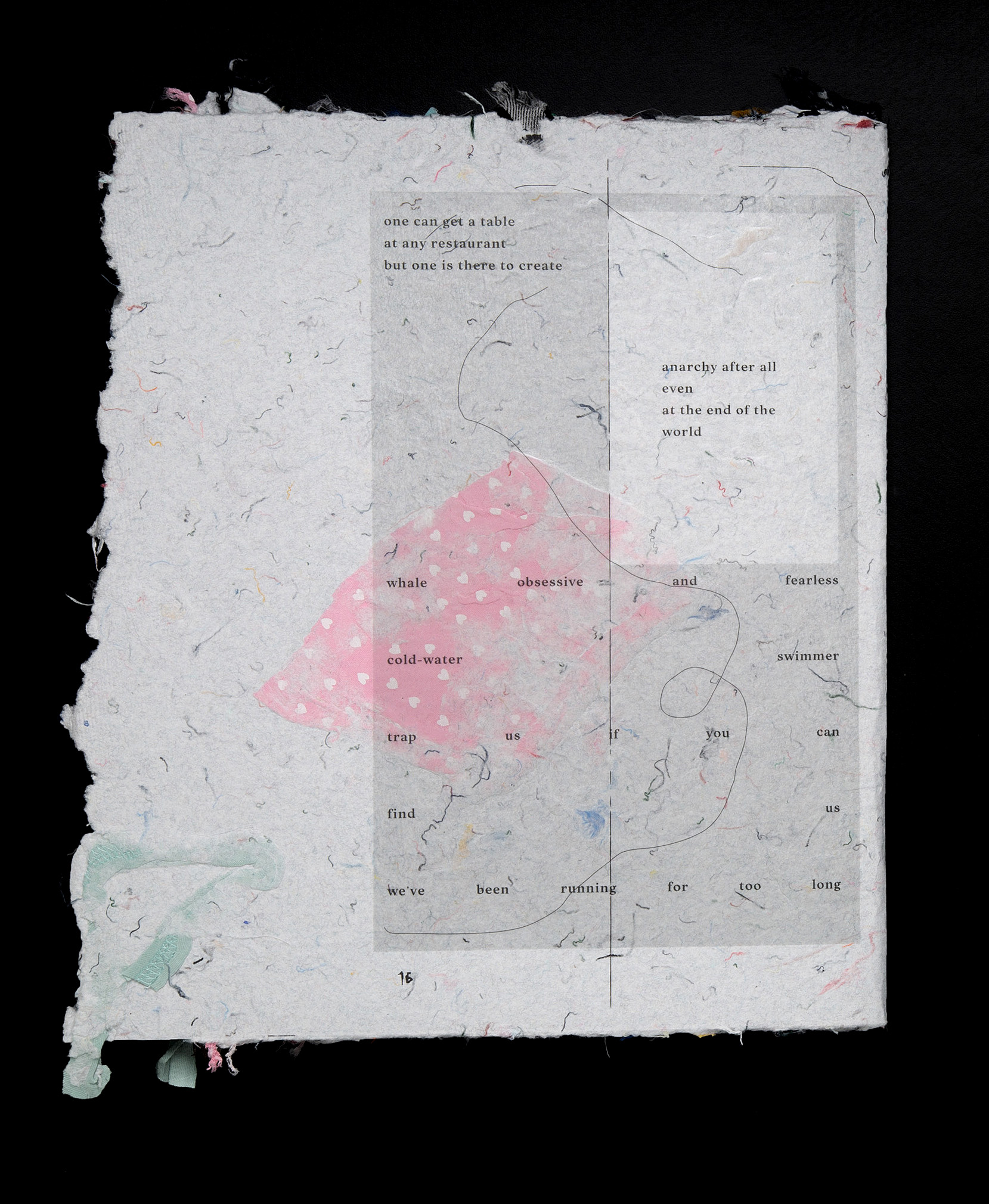
Sinking garbage islands shedding secondhand clothing onto beaches in Kenya and clothing dumps in the Atacama Desert have become familiar sights in our newsfeeds. There is lot of messaging from brands about changing their modes of production, and research into how consumers can change their patterns of consumption and use to avoid the stupendous surplus produced in fashion. Despite this, if the tendency towards "sustainable” production does not engender a reduction in waste or a violent break with the past, then perhaps it is conceivable that in 400 years we would have even more sedimentary layers of discarded textile materials embedded in our landscapes. Are we creating layers for future excavation? Historical records of a moment in time when we made too much? Or simply the base layer on which to continue to pile on more—a rotting, very slowly degrading mixture of soil, sand, insects, mold, fungi, natural fibers, plastics, all the images on the pages of fashion magazines, the fast fashion #hauls on TikTok, and all the white T-shirts that came from origins unknown. All this deposited, no longer individual units but interwoven, formless, garments transcending categories, becoming a slurry in the Earth. A pulp. Our Rags Magazine becomes the fashion magazine of this future.
About the writer
Dr Daphne Mohajer va Pesaran is an academic and designer working in the School of Fashion and Textiles at RMIT University in Melbourne, Australia. Her area of expertise is interspecies collaboration and paper clothing in various cultural contexts. You can find out more here: d-mvp.com (IG: @daphne_mvp), dnj-paper.com (IG @dnj_paper).
About Our Rags Magazine
Imagine what a fashion magazine would look like in 400
years. In a world with no natural resources left, transformation and recycling
are the only way forward.
Our Rags Magazine is a collaborative project by Aimée
Zito Lema and Elisa van Joolen that investigates transformative processes,
proposing new forms of collective production aimed at the reuse of discarded
clothing and textiles. The project and resulting magazine question consumer
behaviour and its relationship to the world in which we live. Further expanding
the potential of recycled material, Our Rags Magazine is a magazine where the
pages not only show clothing, but actually are clothing.
The project started in 2019 with a workshop in which
children were invited to imagine new ways of creating garments and new ways of
dressing. The workshop revolved around dissecting discarded pieces of clothing
brought in by the participating children. Subsequently, all garments were cut
into small pieces and recycled into a new material: paper. A Dutch windmill in
Loenen (NL) which still masters the age-old technique of transforming old rags
in cotton-based paper transformed the shredded garments into coarse and tactile
paper sheets that form the material base of Our Rags Magazine. Returned to the
workshop participants, the kids collectively made highly imaginative garments
from the rags-to-paper material.
Our Rags Magazine pushes the possibilities of recycled material even further. By manufacturing a fashion publication that is printed on this very material – creating a magazine of which the pages don’t merely show the garments, but are the garments – this project shows the creative potential recycling garments and textile can offer.
Designed by Elisabeth Klement, the magazine contains contributions by photographer Janneke van der Hagen and writers Maria Barnas and Persis Bekkering. The project was supported by Rijksakademie van Beeldende Kunsten, Amsterdam and the Prins Bernhard Cultuurfonds.
Published by Warehouse | A Place for Clothes in Context.
More informarion about Warehouse: www.thisiswarehouse.com
Our Rags Magazine: IG @ourragsmagazine
Image credits:
Our Rags Magazine, Aimée Zito Lema & Elisa van Joolen, 2022. Dimensions: 340 mm x 310 mm, paper made from used clothing. Graphic design by Elisabeth Klement, photography by Janneke van der Hagen, styling Lidewij Merckx. Publisher: Warehouse.
